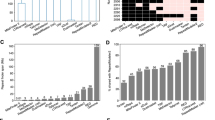Abstract.
Repetitive DNA elements, microsatellites or simple repeats, minisatellites, mobile elements that transpose at the level of DNA, retrotransposons and various derivatives thereof are ubiquitous constituents of all fungal genomes. Many of these elements, especially the different types of transposon, have been cloned and characterised at the sequence level. Their biological role, however, has not yet been sufficiently elucidated. We are far from understanding the selection mechanisms that tend to conserve repeated DNA at defined loci. There is also little insight into the mechanisms that provide the balance between spreading repetitive elements within genomes and control of their copy number. Depending on the fungal group, this balance can be stabilised at different levels. Asco- and basidiomycetes rarely contain more than 5% repetitive DNA, whereas the phylogenetically older division Zygomycota is characterised by typically more than 30%. The effects of repetitive DNAs on the expression of adjacent genes are only rarely understood and their role for genomic plasticity on an evolutionary time scale is still especially enigmatic. This survey summarises the main characteristics of well studied experimental systems and intends to define important open questions for stimulating future research.
Similar content being viewed by others
Author information
Authors and Affiliations
Additional information
Electronic Publication
Rights and permissions
About this article
Cite this article
Wöstemeyer, J., Kreibich, A. Repetitive DNA elements in fungi (Mycota): impact on genomic architecture and evolution. Curr Genet 41, 189–198 (2002). https://doi.org/10.1007/s00294-002-0306-y
Received:
Accepted:
Issue Date:
DOI: https://doi.org/10.1007/s00294-002-0306-y




